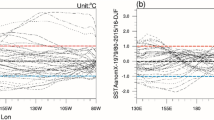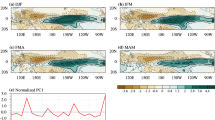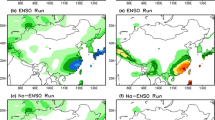Abstract
El Niño events with an eastern Pacific pattern (EP) and central Pacific pattern (CP) were first separated using rotated empirical orthogonal functions (REOF). Lead/lag regression and rotated singular value decomposition (RSVD) analyses were then carried out to study the relation between the surface zonal wind (SZW) anomalies and sea surface temperature (SST) anomalies in the tropical Pacific. A possible physical process for the CP El Niño was proposed. For the EP El Niño, strong westerly anomalies that spread eastward continuously produce an anomalous ocean zonal convergence zone (ZCZ) centered on about 165°W. This SZW anomaly pattern favors poleward and eastward Sverdrup transport at the equator. For the CP El Niño, westerly anomalies and the ZCZ are mainly confined to the western Pacific, and easterly anomalies blow in the eastern Pacific. This SZW anomaly pattern restrains poleward and eastward Sverdrup transport at the equator; however, there is an eastward Sverdrup transport at about 5°N, which favors the warming of the north-eastern tropical Pacific. It is found that the slowness of eastward propagation of subsurface warm water (partly from the downwelling caused by Ekman convergence and the ZCZ) is due to the slowdown of the undercurrent in the central basin, and vertical advection in the central Pacific may be important in the formation and disappearance of the CP El Niño.
Similar content being viewed by others
References
Ashok K, Yamagata T. 2009. The El Nino with a difference. Nature, 461(7263): 481–484.
Ashok K, Behera S K, Rao S A et al. 2007. El Niño Modoki and its possible teleconnection. Journal of Geophysical Research, 112(C11): C11007.
Battisti D S. 1988. Dynamics and thermodynamics of a warming event in a coupled tropical atmosphere-ocean model. Journal of the Atmospheric Sciences, 45(20): 2 889–2 919.
Behringer D, Xue Y. 2004. Evaluation of the global ocean data assimilation system at NCEP: the Pacific Ocean. Eighth Symposium on Integrated Observing and Assimilation Systems for Atmosphere, Oceans, and Land Surface, Seattle, WA. https://ams.confex.com/ams/pdfpapers/70720.pdf. Accessed on 2012-11-23.
Chao J P, Yuan S Y, Chao Q C et al. 2003. The origin of warm water mass in warm pool subsurface of the western tropical Pacific-the analysis of the 1997–1998 El Niño. Chinese Journal of Atmospheric Sciences, 27(2): 145–151. (in Chinese with English abstract)
Chen J N, Song G T, Chu J T et al. 2003. Oceanic temperature anomalous signal pathway in the equatorial Pacific. Advances in Water Science, 14(2): 152–157. (in Chinese with English abstract)
Cheng X, Dunkerton T J. 1995. Orthogonal rotation of spatial patterns derived from singular value decomposition analysis. Journal of Climate, 8(11): 2 631–2 643.
Choi J, An S I, Kug J S et al. 2011. The role of mean state on changes in El Niño’s flavor. Climate Dynamics, 37(5): 1 205–1 215.
Collins M, An S I, Cai W et al. 2010. The impact of global warming on the tropical Pacific Ocean and El Niño. Nature Geoscience, 3(6): 391–397.
Horel J D. 1981. A rotated principal component analysis of the interannual variability of the Northern Hemisphere 500 mb height field. Monthly Weather Review, 109(10): 2 080–2 092.
Huang R, Zhang R, Yan B. 2001. Dynamical effect of the zonal wind anomalies over the tropical western Pacific on ENSO cycles. Science in China Series D: Earth Sciences, 44(12): 1 089–1 098.
Kalnay E, Kanamitsu M, Kistler R et al. 1996. The NCEP/NCAR 40-year reanalysis project. Bulletin of the American Meteorological Society, 77(3): 437–471.
Kao H Y, Yu J Y. 2009. Contrasting eastern-Pacific and central-Pacific types of ENSO. Journal of Climate, 22(3): 615–632.
Kim W M, Yeh S W, Kim J H et al. 2011. The unique 2009–2010 El Niño event: a fast phase transition of warm pool El Niño to La Niña. Geophysical Research Letters, 38(15): L15809.
Kug J S, Kang I S, An S I. 2003. Symmetric and antisymmetric mass exchanges between the equatorial and off-equatorial Pacific associated with ENSO. Journal of Geophysical Research, 108(C8): 3 284.
Kug J S, Jin F F, An S I. 2009. Two types of El Niño events: cold tongue El Niño and warm pool El Niño. Journal of Climate, 22(6): 1 499–1 515.
Larkin N K, Harrison D. 2005a. On the definition of El Niño and associated seasonal average US weather anomalies. Geophysical Research Letters, 32(13): L13705.
Larkin N K, Harrison D. 2005b. Global seasonal temperature and precipitation anomalies during El Niño autumn and winter. Geophysical Research Letters, 32: L16705.
Lau K M. 1981. Oscillations in a simple equatorial climate system. Journal of Atmospheric Sciences, 38: 248–261.
Lee T, McPhaden M J. 2010. Increasing intensity of El Niño in the central-equatorial Pacific. Geophysical Research Letters, 37(14): L14603.
Li C Y, Mu M Q. 1999. El Niño occurrence and sub-surface ocean temperature anomalies in the pacific warm pool. Chinese Journal of Atmospheric Sciences, 23(5): 513–521. (in Chinese with English abstract)
Lian T, Chen D. 2012. An evaluation of rotated EOF analysis and its application to tropical pacific SST variability. Journal of Climate, 25(15): 5 361–5 373.
McPhaden M J. 1999. Genesis and Evolution of the 1997–98 El Niño. Science, 283(5404): 950–954.
Mu M Q, Li C Y. 2000. Interactions between subsurface ocean temperature anomalies in the western pacific warm pool and ENSO cycle. Chinese Journal of Atmospheric Sciences, 24(4): 447–460. (in Chinese with English abstract)
Rasmusson E M, Carpenter T H. 1982. Variations in tropical sea surface temperature and surface wind fields associated with the Southern Oscillation/El Niño. Monthly Weather Review, 110(5): 354–384.
Rayner N, Parker D, Horton E et al. 2003. Global analyses of sea surface temperature, sea ice, and night marine air temperature since the late nineteenth century. Journal of Geophysical Research, 108(D14): 4407.
Schopf P S, Suarez M J. 1988. Vacillations in a coupled oceanatmosphere model. Journal of the atmospheric sciences, 45(3): 549–566.
Weisberg R H, Wang C. 1997. A western pacific oscillator paradigm for the El Niño-southern oscillation. Geophysical research letters, 24(7): 779–782.
Wittenberg A T. 2009. Are historical records sufficient to constrain ENSO simulations. Geophysical Research Letters, 36: L12702.
Wyrtki K. 1975. El Niño-the dynamic response of the equatorial pacific ocean to atmospheric forcing. Journal of Physical Oceanography, 5(4): 572–584.
Yeh S W, Kug J S, Dewitte B et al. 2009. El Niño in a changing climate. Nature, 461(7263): 511–514.
Yu J Y, Kim S T. 2010. Three evolution, patterns of central Pacific El Niño. Geophysical Research Letters, 37: L08706.
Zhang W, Li J, Zhao X. 2010. Sea surface temperature cooling mode in the Pacific cold tongue. Journal of Geophysical Research, 115(C12): C12042.
Author information
Authors and Affiliations
Corresponding author
Additional information
Supported by the National Natural Science Foundation of China (Nos. 41076010, 41206017) and the National Basic Research Program of China (973 Program) (No. 2012CB417402)
Rights and permissions
About this article
Cite this article
Wang, Y., Chen, J. & Wang, H. Distribution of the tropical Pacific surface zonal wind anomaly and its relation with two types of El Niño. Chin. J. Ocean. Limnol. 31, 1137–1152 (2013). https://doi.org/10.1007/s00343-013-2294-9
Received:
Accepted:
Published:
Issue Date:
DOI: https://doi.org/10.1007/s00343-013-2294-9




